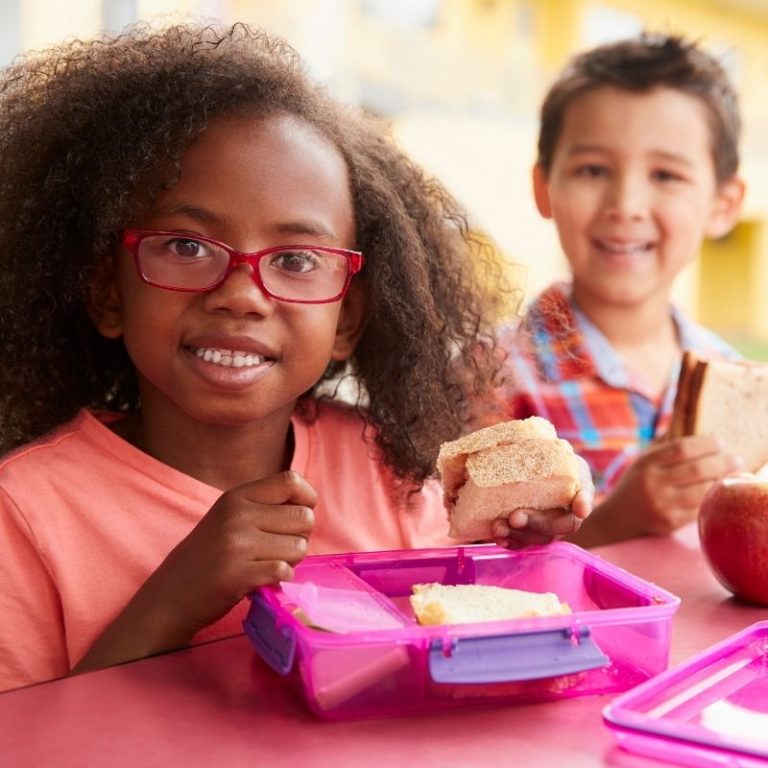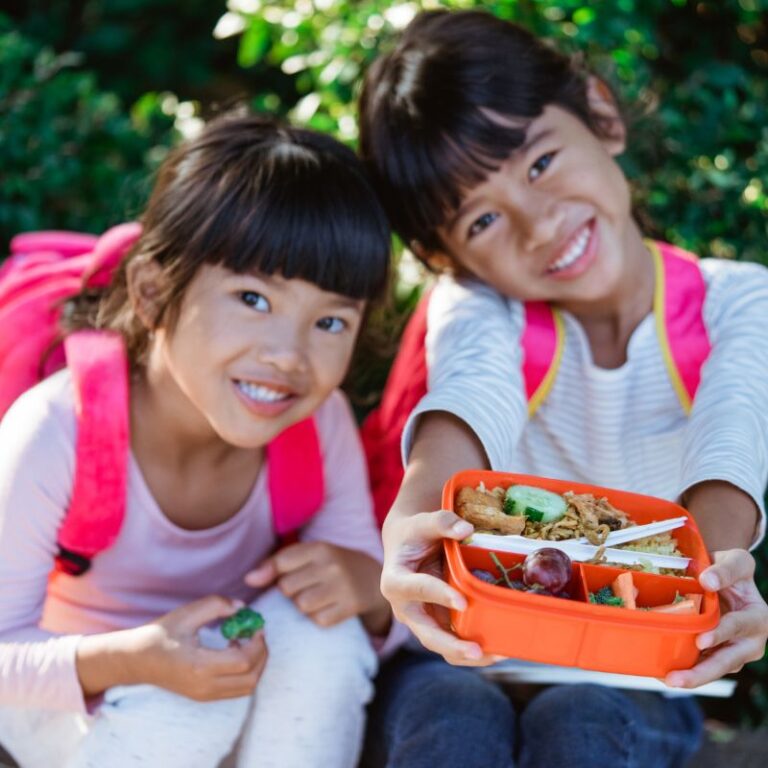Have you ever asked your child to eat their “healthy food first”?
I’m sure I have. I know in the process of my learning (and un-learning) that this is something I might have communicated years back. My experience working with families for over a decade is that many adults provide this advice to a young eater as well.
Why? Because at the core of this statement is love. Parents, caregivers, teachers and other adults in a child’s life have an honest desire to help a child nourish and fuel their bodies with the best foods possible to support their education, growth and development. Behind the encouragement for a child to eat “healthy foods first” is the desire for their tummy to fill up on foods that have many nutrients, saving the foods with a smaller number of nutrients for later.
However, despite our good intentions behind this plea to eat “healthy foods first”, it’s not doing what we think it’s doing.
We know more now about the unintended consequences of labelling foods for kids than we ever have before. Thanks to research and years of practice experience, we can now do better for the next generation.
Many parents seek our support at Blueprint Nutrition with the goal to raise competent and adventurous eaters who also have a good relationship with food. If this is your goal too, read on to understand more about why asking kids to eat their “healthy food first” may not be the best practice and what we can do instead.
5 reasons why we shouldn’t ask kids to eat their “healthy food first?”
1. The word “healthy” is controversial and confusing.
What is healthy food? Your definition is likely different than mine. It’s not just different between individuals and families but across cultures too. It gets very political very quickly.
Are beans (kidney beans, black beans etc.) healthy? To someone following a vegetarian diet, likely yes. For someone following a ketogenic diet, probably not. If you’re looking at Canada’s Food Guide, you’d probably say yes.
Is a brownie healthy or unhealthy? Is it unhealthy if it’s purchased from the store? Would you think that it’s healthy if it’s homemade? Or is it healthy only if it’s made with shredded zucchini, Greek yogurt and minimal added sugar? Perhaps you would say at the end of the day that a brownie and always unhealthy?
Don’t forget that medical conditions affect what type of food is “healthy” for a child. Healthy food for a child with type 1 diabetes will look different than for a child with extreme picky eating.
Everyone defines “healthy” through their own lens. Asking kids to eat “healthy food first” makes the assumption that families define healthy the same way. It also implies that all families have the resources and desire to send these foods to school (or cook these foods at home).
The other fact of the matter is that most kids don’t grocery shop. So talking to kids about eating “healthy food” is not helpful when they don’t determine what goes in the grocery cart.
2. It can cause food guilt which leads to a poor relationship with food and disordered eating.
Kids are black and white thinkers. If you’re an educator or have read books on childhood development, you have likely come across Piaget’s Stages of Development and his theory of cognitive development in kids. In Piaget’s theory, he notes that kids are very concrete thinkers until closer to the age of 11-12 years when they begin to develop some ability to engage in abstract thought. So, talking to kids about “healthy” or categorizing food before then inevitably leads to a lot of confusion and misinterpretation.
Younger kids see categories of “healthy” and “unhealthy” food (or “everyday” and “sometimes” foods – same thing) as black and white. Healthy = good food and unhealthy = bad food. This in turn moralizes food and makes kids feel bad if they eat or enjoy unhealthy food.
As mentioned in another post, this black and white categorization of food is at the root of food guilt (feeling guilty or shameful when eating “unhealthy” food). Research supports that food guilt is related to body dissatisfaction and increased risk for dieting behaviours and ultimately disordered eating and/or eating disorders.
There is also the unintended consequence of children learning to become judges of others’ food or what others are eating. We all make food choices for a variety of reasons and judging what others eat is not fair or helpful when it comes time to raising non-judgmental and food neutral kids.
3. It backfires.
Telling a child to eat their healthy food first reinforces their perception that healthy food = yucky food. You have to eat it first before you get to the good stuff. It sets them up to believe that “unhealthy food” is a reward or prize for getting the “healthy” stuff down. This further perpetuates the idea that foods higher in sugar or salt or fat are “reward foods” and fruits and veggies are “punishment foods.”
For those who are trying to raise adventurous eaters (aka – you have a picky eater at home) it actually causes more disinterest in the foods that are labelled as healthy. “Eat these, they’re healthy” is not the key to convince your child to happily eat their veggies. Education (or categorization) isn’t the magic bullet to solve problematic eating.
On the flip side, if you have a child who is a rule-follower or people pleaser, they might enjoy doing what’s expected of them by eating their “healthy food first”. For some children, this turns into a feeling of virtuousness by always (or only) eating the healthy foods. Consequently, we’ve seen this trigger disordered eating and eating disorders time and time again.
4. It’s hard to eat when you’re being micromanaged.
Put yourself in your child’s shoes for a minute. Imagine a friend sitting down with you at the lunch table. Your friend proceeds to analyze your lunch before telling you to eat your carrots before your sugary brownie. It would likely be an incredibly awkward situation. You may experience a wide range of emotions from feeling judged to feeling sad, embarrassed, or angry.
When we label food or dictate the order food is eaten in, it causes kids to feel more pressure. Feeling pressure to eat is linked to increased anxiety for kids. Anxiety is a robber of appetite, which leads to increased food refusals, and more severe picky eating. Nutrient deficiencies follow, along with many other concerns.
5. Biochemistry is not the only factor at play.
Yes, it’s absolutely true that eating a balance of macronutrients (fat, protein and carbs) and micronutrients (vitamins and minerals) is important for children (for everyone!). It’s also ideal to have some protein-rich food combined with carbohydrate-rich food to help provide sustained energy throughout the day.
Unfortunately, it still doesn’t change the fact that not all families can afford these foods and many kids simply do not have a palate that extends far beyond a limited range of less nutrient-dense foods.
There is also the added challenge of food allergies in schools. Many schools ask that you not send certain foods to school. I worked with a family last year whose child was not allowed to pack nuts, sesame seeds or tahini, fish, eggs (could send in baked goods), peaches or bananas due to food allergies in the class. For their 5-year-old who was already a selective (picky) eater, it was a big challenge. Food allergies are so hard and I completely respect the hurdles families face for children with allergies. It simply makes it even more challenging to send a variety of nutrient-dense and accepted food for kids who may not be foodies by nature.
Oftentimes there is also a fear that a child who eats a brownie at first nutrition break will become hyperactive the rest of the day. This association between sugar and hyperactivity is not substantiated in research. Studies have shown that even when sugar intake exceeds typical levels, sugar does not negatively impact children’s behaviour or cognitive functioning. This is not to discredit your observations of your own child but usually there are other precipitating factors to why children act different when foods higher in sugar are present.
So what should we or can we do instead?
Instead of focusing on GETTING our kids to eat certain foods, why not simply LET them eat!
Here are a few suggestions depending if you are reading this from a parent/caregiver perspective or a school/teacher perspective.
Parents and caregivers:
When packing lunches for school, simply focus on providing food that:
- Is safe for your child
- Fits in your household food budget
- You can prepare in the time you have available
- Considers taste preferences without catering
- Complies with allergies or medical conditions
- Exposes your child in gentle ways to new foods
- Fills their nutritional requirements
- Provides comfort
When eating at home, instead of focusing your efforts on pushing “healthy”, why not simply model the eating and enjoyment of a variety of foods right at the dinner table?! Research supports that modelling healthy eating and regular family mealtimes is far more effective than other rule-based schemas.
Most importantly, by following the division of responsibility in feeding framework, we focus on our jobs as parents to provide the what, when, and where of eating and allow our kids to decide if and how much (and in what order) they will eat. It’s a trust-based model of feeding that works so well to raise competent and intuitive eaters.
Schools:
Schools can work towards creating pleasant mealtime environments:
- Safe, clean and well-lit space for children to eat their lunches
- Noise levels that are conducive to eating
- Zero tolerance policies regarding food bullying (e.g. kids commenting on the sight or smell of others’ food etc.)
- Education for lunch helpers and supervisors to avoid labelling foods as healthy or unhealthy
- Working to create food neutral and body positive classrooms
If a child needs a reminder to explore their thermos food first to help them avoid food poisoning (those thermoses don’t keep food at a safe temperature for long at all!), I personally think that’s helpful. Otherwise, engaging with the kids outside of nutrition breaks around food is best.
Both parents and teachers can shift away from teaching food categories and instead focus on how food is made (or how it grows). Consider this example about apples which may be relevant this time of year!
- How do apples grow? (Visit an orchard or watch a video)
- How do farmers harvest apples? (Watch a video or have a zoom chat with an apple farmer)
- Talk about the different varieties of apples (Buy a few different varieties at the grocery store)
- If your child is willing, do a blind-folded apple taste test and try to identify the varieties
- Talk about how apples can be eaten – raw vs. cooked (Look up different recipes)
- For older kids, talk about why apples brown (enzymatic browning) and get them to consider what to do to stop this process
You can work through this same exploration series with other foods like fruits, vegetables, grains, calcium-rich foods or any other foods you want to explore.
Lastly, consider advocating for a national school lunch program that provides hot meals for children at schools so all kids can have access to nutritious foods to promote learning. Canada remains one of the very few industrialized countries without a national school lunch program. (More here).
If you’re interested in talking about this further, please reach out. It’s never too late to change our language around food!
P.S. For schools and teachers looking for more support, Blueprint Nutrition partners with and endorses the work of Dietitians 4 Teachers.






